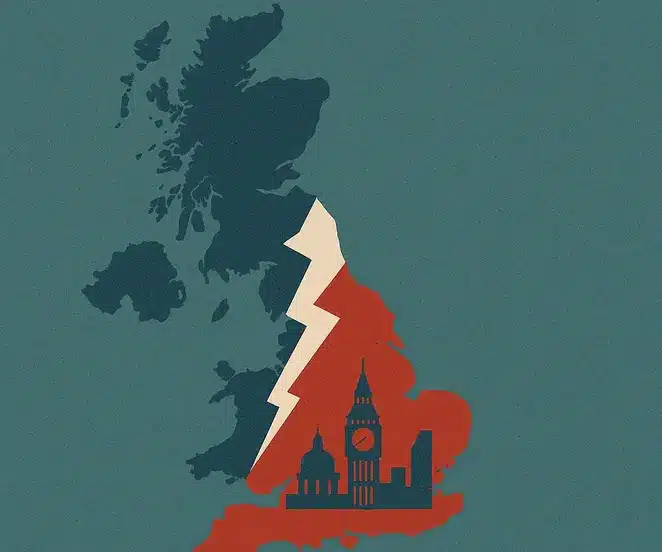The Stark Reality of Britain’s Divide
London stands as one of the world’s wealthiest cities with 215,700 millionaires, 516 centi-millionaires, and 45 billionaires. Yet the rest of the United Kingdom tells a dramatically different story. British citizens outside London have less disposable income than the poorest five US states and the average OECD country. Remove London and the southeast from calculations, and UK GDP per capita drops 14%. Life expectancy in parts of Blackpool falls below Rwanda’s levels, while entire cities that once thrived now rank among Western Europe’s poorest.
This transformation from the world’s greatest kingdom to regional squalor began in 1979 with Margaret Thatcher’s election and her aggressive campaign against inflation that would reshape Britain’s economic geography forever.
The Inflation Crisis That Started It All
Britain entered the 1970s facing economic chaos. Inflation had spiraled out of control—£100 in 1970 was worth over £300 by 1979. Multiple factors converged to create this perfect storm. Two massive oil shocks saw OPEC double and then triple oil prices, making everything from gas to groceries expensive overnight. Simultaneously, powerful trade unions demanded higher wages to keep pace with rising prices, creating a vicious cycle of inflation feeding wage increases feeding more inflation.
Loose monetary and fiscal policies flooded the economy with money, compounding the problem. Thatcher’s government, guided by Chancellor Geoffrey Howe and monetarists like Keith Joseph and Alan Walters, made inflation enemy number one. Their strategy was brutally simple: strangle the money supply, raise interest rates, and cut government spending.
The Thatcher Shock Treatment
The Thatcher government slashed sterling M3 growth from 12% annually to just 6% by 1984. Interest rates climbed from 12% in June 1979 to 14%, then 17% in November—the highest in British history. The goal was making borrowing expensive enough to choke off inflation, but the consequences were devastating.
While inflation dropped from 13% in 1979 to 5% by 1983, the stronger pound made British exports uncompetitive abroad while sky-high borrowing costs crippled domestic businesses. Manufacturers couldn’t invest, expand, or even keep operations running. Government spending cuts reduced public sector borrowing from 4.7% of GDP in 1979 to 1.5% by 1983, while taxes actually increased during the recession.
The shock was so severe that 364 economists signed a letter to The Times declaring the policy had no basis in economic theory. Unemployment exceeded 2 million people, with 100,000 joining unemployment lines monthly. Britain’s industrial base was gutted, and regional inequality began taking permanent shape.
The Big Bang and London’s Financial Revolution
While manufacturing towns collapsed across northern England, Scotland, and Wales, London experienced a different story. Thatcher had a vision of transforming London into a financial superpower through the Big Bang deregulation package. Fixed commissions and exchange controls were scrapped, the single capacity rule ended, foreign ownership welcomed, and electronic trading unleashed.
The results were spectacular. International banks poured £450 million into the city, 1,500 new millionaires were minted, and London cemented itself as the world’s dominant financial center. On paper, Britain experienced a renaissance. GDP rose from £1 trillion to £1.4 trillion by 1990, while GDP per capita increased from £15,500 to £19,900.
However, this data masked a darker reality. The Gini coefficient measuring inequality increased from 25 to 35 during the same period. While GDP per capita rose 30%, inequality rose 40%. Britain was richer but becoming dramatically more unequal.
The Manufacturing Collapse
The cost of Thatcher’s policies on Britain’s industrial base was catastrophic. Manufacturing accounted for nearly 30% of UK GDP in 1979 but fell to 16% by 1990. Manufacturing employment dropped nearly 40% from 1979 to 1993. The shift from manufacturing to services had profound implications beyond simple job numbers.
Manufacturing creates extensive indirect employment. Opening a widget factory might hire 100 people directly, but requires steel, electricity, distributors, and suppliers—creating 300 indirect jobs for a 1:3 ratio. Banking creates only 200 indirect jobs per 100 direct jobs (1:2 ratio), while iron manufacturing creates over 900 indirect jobs per 100 direct jobs (1:9 ratio).
Manufacturing jobs also provided formal employment agreements with strong benefits, retirement plans, paid holidays, insurance, and sick leave. Service sector alternatives for low-skilled workers lacked these characteristics. Studies show the shift away from manufacturing directly increased inequality.
The Regional Devastation
Britain’s industrial base was deeply regionalized, meaning the manufacturing collapse devastated specific areas while sparing others. Today, not a single region north of London has GDP per capita higher than the UK average. Every region excluding London and the southeast is poorer than the national average.
Joblessness in northern England, Scotland, and Wales pushed past 15% by the mid-1980s, while the southeast and London stayed under 10%. This created a hollowing-out effect where historically prosperous industrial towns became economic wastelands.
Interestingly, despite London’s wealth, Britons actually move away from London more than they move to it. London has a negative internal mobility rate—one of the only UK cities with this pattern. While median household incomes are 14% higher in London, housing costs are nearly double the UK average. After factoring in housing, household incomes are only 1% higher in London, making migration economically irrational unless you’re in the top quartile of earners.
The Housing Crisis
London’s housing problems stem partly from Thatcher’s Right to Buy scheme introduced in 1980. This policy privatized social housing by allowing tenants to purchase homes at steep discounts—initially 33% for houses and 50% for flats, later raised to 70%. Local authorities offered mortgages with no deposit required.
The math was irresistible: buy property at 0% down with a 70% discount, sell at market value years later (untaxed), and pocket massive profits. London had around 715,000 social homes in 1980, representing nearly 30% of housing stock. Today, only 390,000 remain, with social housing comprising just 10% of stock—a 61% decrease.
Across the UK, at least 40% of Right to Buy homes are now rented at market rates. The policy economically benefited current generations at the expense of future ones without ensuring affordable housing stock remained available.
Foreign Investment and Non-Dom Status
London’s housing crisis is exacerbated by foreign investment. Unlike other major cities, Britain has no legal restrictions preventing foreign nationals from purchasing property. Roughly 27% of London’s residential property sales in Q1 2024 went to foreign buyers, compared to 0.3% in New York—a 90-fold difference.
Over 20% of new rental properties have at least one foreign shareholder, doubling from 2016. The UK’s non-dom tax status (now abolished) enabled residents claiming permanent homes abroad to avoid UK tax on foreign income and capital gains. While 83,000 non-doms brought money from abroad, they competed with locals for scarce housing without contributing proportionally to local services, business creation, or employment.
The Foreign Stake in UK Housing
Over 20% of new UK rental properties now have foreign shareholders — double the 2016 share. The abolished non-dom tax status once allowed residents with overseas homes to avoid UK taxes, intensifying competition for limited housing. While 83,000 non-doms injected foreign capital, they contributed little to local infrastructure, services, or job creation.
Explore Real Estate & Policy Analysis Roles →Infrastructure Neglect Beyond London
The deeper issue is where Britain invests its money, and for decades the answer has been London. Transport investment per person reaches nearly £1,200 in London compared to £430 in the northeast and £350 in the East Midlands. If the North had been funded at London’s per-person rate, it would have received an extra £140 billion—equivalent to building seven Elizabeth lines.
Britain underspends on transport compared to peers. The UK invested just 0.3% of GDP annually in roads between 1995 and 2020, compared to Italy’s 0.4%, Germany and the US at 0.5%, and France at over 0.6%. This underinvestment makes cities outside London less productive by limiting effective city size, reducing commuting possibilities, and connecting fewer jobs.
The UK is unique in Western Europe where city size doesn’t correlate strongly with economic productivity—poor infrastructure drives this anomaly.
R&D Concentration
The same neglect appears in research and development. Government R&D expenditure concentrates in higher productivity, higher income locations—London. In 2016, the government spent £21 per person on R&D in northern England and £14 in the Midlands, but £60 in London.
This creates a reinforcing loop: more R&D means London firms grow faster, attracting more private capital, funding even more R&D. Germany’s poorer regions receive more public R&D support, but Britain does the opposite. Areas needing support most receive scraps, deepening inequality instead of fixing it.
The Homelessness Crisis
London’s housing crisis manifests in homelessness levels unseen elsewhere in the Western world. Advocates counted over 13,000 rough sleepers in 2024, a 10% increase from the previous year and 63% increase from a decade ago. Overall, 2% of Londoners are considered homeless, compared to New York at 0.8%, Toronto at 0.5%, Paris at 0.3%, Berlin at 0.3%, and Amsterdam at 0.2%.
The Broken Promise
Tony Blair once promised that “the kaleidoscope has been shaken. The pieces are in flux. Soon they will settle again. Before they do, let us reorder this world around us.” Two decades later, the only thing reordered has been the United Kingdom around London.
Britain still possesses ingredients for prosperity—money, power, and prestige—but they’re concentrated in a few square miles along the Thames. For everyone else, the empire is gone, factories are gone, and the future is shrinking. London sits eating Michelin-starred food while the rest of the UK eats scraps in alleyways.
Frequently Asked Questions
Q: How did Thatcher’s policies create regional inequality?
A: Thatcher’s high interest rates and strong pound devastated manufacturing towns across northern England, Scotland, and Wales while London’s service-based economy thrived through financial deregulation, creating permanent regional economic divides.
Q: Why is London so much wealthier than the rest of the UK?
A: The Big Bang deregulation transformed London into a global financial center, attracting international banks and creating 1,500 new millionaires, while manufacturing employment dropped 40% across industrial regions.
Q: What was the Right to Buy scheme’s impact on housing?
A: Thatcher’s policy allowed social housing tenants to buy homes at 70% discounts with no deposits, reducing London’s social housing from 30% to 10% of stock while 40% of sold homes are now rented at market rates.
Q: Why don’t more Britons move to London despite higher incomes?
A: While London’s median household incomes are 14% higher, housing costs are nearly double the UK average, making net incomes only 1% higher unless you’re in the top quartile of earners.
Q: How does infrastructure investment favor London?
A: London receives £1,200 per person in transport investment compared to £430 in the northeast and £350 in the East Midlands, while R&D spending is £60 per person in London versus £21 in northern England.
Q: What caused Britain’s manufacturing collapse?
A: Thatcher’s 17% interest rates and strong pound made British exports uncompetitive while crippling domestic manufacturers who couldn’t afford to invest, expand, or maintain operations during the anti-inflation campaign.




